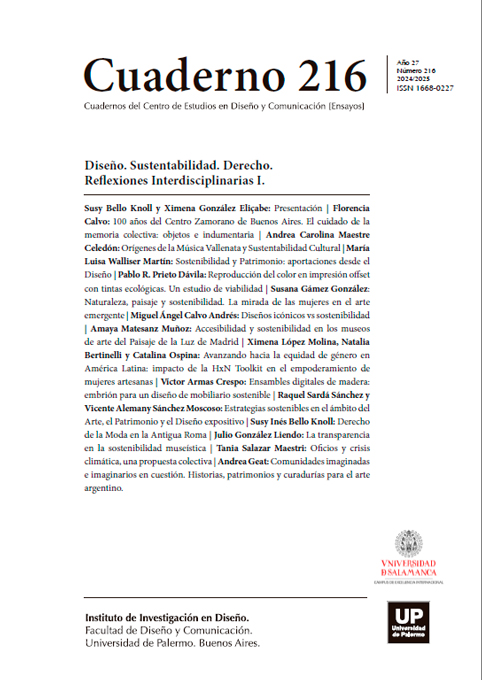Reproducción del color en impresión offset con tintas ecológicas. Un estudio de viabilidad
Palabras clave:
tintas, ecológicas
Resumen
Alrededor de la década de los 2000 se empezaron a desarrollar y formular tintas para impresión offset a las que se ha denominado como ecológicas.
Citas
Aydemir, C., Yenidoğan, S., Karademir, A., & Arman Kandirmaz, E. (2018). The examination of vegetable- and mineral oil-based inks’ effects on print quality: Green printing effects with different oils. Journal of Applied Biomaterials & Functional Materials, 137-143. doi:10.1177/2280800018764761
Ha, Y.-B., Ming Yu, J., Sung-Sang, O., & Do-Hyun, R. (2012). Synthesis of an Environmentally Friendly Phenol-Free Resin for Printing Ink. Bulletin of the Korean Chemical Society, 3413–3416. doi:10.5012/BKCS.2012.33.10.3413
Hayta, P., Oktav, M., & Ateş Duru, Ö. (2021). An ecological approach to printing industry: Development of ecofriendly offset printing inks using vegetable oils and pine resin as renewable raw materials and evaluation of printability. Color Research and Application, 164-171. doi:10.1002/col.22708
Min Park, J., Han Kim, Y., & Bin Kim, S. (2013). Development of Solvent-Free Offset Ink Using Vegetable Oil Esters and High Molecular-Weight Resin. Journal of Oleo Science, 345-352. doi:10.5650/jos.62.345
Moon, S.-H., Kim, S.-S., Koo, C.-W., & Yoo, K.-R. (2010). A Study on the Color Reproduction for Offset Printing using Ecological Ink in the Domestic Printing Environment. Journal of the Korean Graphic Arts Communication Society, 1226-1149. Obtenido de https://koreascience.kr/article/JAKO201018752858346.page
Nandini, N., Hema, P., & R.Viveka, T. (2021). Survey for identifying non-eco friendly printing activities in various stages of printing workflow. International Journal of Engineering Applied Sciences and Technology, 168-175. Obtenido de https://ijeast.com/papers/168-175,Tesma601,IJEAST.pdf
Park, J.-M., & Kim, S.-B. (2011). The Variation of Offset Ink Properties According to Methyl Ester of Soy Oil and Resin Molecular Weight. Journal of the Korean Graphic Arts Communication Society, 45-59. Retrieved from https://koreascience.kr/article/JAKO201126239076091.page
Park, J.-M., & Kim, S.-B. (2012). The Variation of Offset Ink Properties according to the Vegetable Oil Estersr. Journal of the Korean Graphic Arts Communication Society, 1-19. Obtenido de https://koreascience.kr/article/JAKO201224963702504.page
Rossitza, S. (2015). Offset Printing without Isopropyl Alcohol in Damping Solution. Energy Procedia, 690-698. doi:10.1016/j.egypro.2015.07.804
Sang-Hoon, K. (2003). Colorimetric Evaluation on Color Reproduction Properties of the Colorants for Offset Printing and Proofing. Journal of the Korean Graphic Arts Communication Society, 31-42. Obtenido de https://koreascience.kr/article/JAKO200315875827902. page
Ha, Y.-B., Ming Yu, J., Sung-Sang, O., & Do-Hyun, R. (2012). Synthesis of an Environmentally Friendly Phenol-Free Resin for Printing Ink. Bulletin of the Korean Chemical Society, 3413–3416. doi:10.5012/BKCS.2012.33.10.3413
Hayta, P., Oktav, M., & Ateş Duru, Ö. (2021). An ecological approach to printing industry: Development of ecofriendly offset printing inks using vegetable oils and pine resin as renewable raw materials and evaluation of printability. Color Research and Application, 164-171. doi:10.1002/col.22708
Min Park, J., Han Kim, Y., & Bin Kim, S. (2013). Development of Solvent-Free Offset Ink Using Vegetable Oil Esters and High Molecular-Weight Resin. Journal of Oleo Science, 345-352. doi:10.5650/jos.62.345
Moon, S.-H., Kim, S.-S., Koo, C.-W., & Yoo, K.-R. (2010). A Study on the Color Reproduction for Offset Printing using Ecological Ink in the Domestic Printing Environment. Journal of the Korean Graphic Arts Communication Society, 1226-1149. Obtenido de https://koreascience.kr/article/JAKO201018752858346.page
Nandini, N., Hema, P., & R.Viveka, T. (2021). Survey for identifying non-eco friendly printing activities in various stages of printing workflow. International Journal of Engineering Applied Sciences and Technology, 168-175. Obtenido de https://ijeast.com/papers/168-175,Tesma601,IJEAST.pdf
Park, J.-M., & Kim, S.-B. (2011). The Variation of Offset Ink Properties According to Methyl Ester of Soy Oil and Resin Molecular Weight. Journal of the Korean Graphic Arts Communication Society, 45-59. Retrieved from https://koreascience.kr/article/JAKO201126239076091.page
Park, J.-M., & Kim, S.-B. (2012). The Variation of Offset Ink Properties according to the Vegetable Oil Estersr. Journal of the Korean Graphic Arts Communication Society, 1-19. Obtenido de https://koreascience.kr/article/JAKO201224963702504.page
Rossitza, S. (2015). Offset Printing without Isopropyl Alcohol in Damping Solution. Energy Procedia, 690-698. doi:10.1016/j.egypro.2015.07.804
Sang-Hoon, K. (2003). Colorimetric Evaluation on Color Reproduction Properties of the Colorants for Offset Printing and Proofing. Journal of the Korean Graphic Arts Communication Society, 31-42. Obtenido de https://koreascience.kr/article/JAKO200315875827902. page
Publicado
2024-03-27
Cómo citar
Prieto Dávila, P. R. (2024). Reproducción del color en impresión offset con tintas ecológicas. Un estudio de viabilidad. Cuadernos Del Centro De Estudios De Diseño Y Comunicación, (216). https://doi.org/10.18682/cdc.vi216.11030
Sección
Artículos
Los autores/as que publiquen en esta revista ceden los derechos de autor y de publicación a "Cuadernos del Centro de Estudios de Diseño y Comunicación", Aceptando el registro de su trabajo bajo una licencia de atribución de Creative Commons, que permite a terceros utilizar lo publicado siempre que de el crédito pertinente a los autores y a esta revista.


